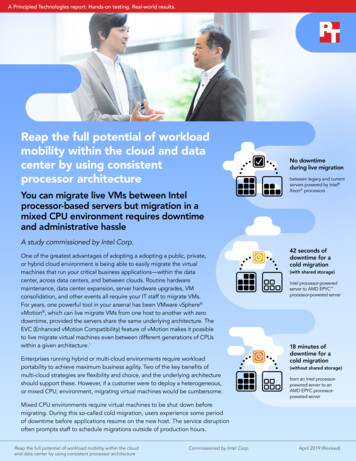
Transcription
A Principled Technologies report: Hands-on testing. Real-world results.Reap the full potential of workloadmobility within the cloud and datacenter by using consistentprocessor architectureYou can migrate live VMs between Intelprocessor-based servers but migration in amixed CPU environment requires downtimeand administrative hassleA study commissioned by Intel Corp.One of the greatest advantages of adopting a adopting a public, private,or hybrid cloud environment is being able to easily migrate the virtualmachines that run your critical business applications—within the datacenter, across data centers, and between clouds. Routine hardwaremaintenance, data center expansion, server hardware upgrades, VMconsolidation, and other events all require your IT staff to migrate VMs.For years, one powerful tool in your arsenal has been VMware vSphere vMotion , which can live migrate VMs from one host to another with zerodowntime, provided the servers share the same underlying architecture. TheEVC (Enhanced vMotion Compatibility) feature of vMotion makes it possibleto live migrate virtual machines even between different generations of CPUswithin a given architecture.1Enterprises running hybrid or multi-cloud environments require workloadportability to achieve maximum business agility. Two of the key benefits ofmulti-cloud strategies are flexibility and choice, and the underlying architectureshould support these. However, if a customer were to deploy a heterogeneous,or mixed CPU, environment, migrating virtual machines would be cumbersome.No downtimeduring live migrationbetween legacy and currentservers powered by Intel Xeon processors42 seconds ofdowntime for acold migration(with shared storage)Intel processor-poweredserver to AMD EPYC processor-powered server18 minutes ofdowntime for acold migration(without shared storage)from an Intel processorpowered server to anAMD EPYC processorpowered serverMixed CPU environments require virtual machines to be shut down beforemigrating. During this so-called cold migration, users experience some periodof downtime before applications resume on the new host. The service disruptionoften prompts staff to schedule migrations outside of production hours.Reap the full potential of workload mobility within the cloudand data center by using consistent processor architectureCommissioned by Intel Corp.April 2019 (Revised)
CIOs whose data centers have deployed servers powered by Intel Xeon processors and are consideringdeploying new servers based on the AMD EPYC line of processors into this environment should consider howdoing so would limit their workload mobility. As AMD notes in their Virtual Machine Migration Guide, whenmoving VMs between EPYC processor-based servers and servers powered by Intel processors, live migration isnot an option.2Live migrationCold migrationAbout the servers andprocessors we testedIntel to IntelIntel to AMDIn our hands-on testing, we migrated VMs in ahomogeneous environment of only Intel Xeon processorbased servers and in a heterogeneous environmentconsisting of both Intel Xeon processor- and AMD EPYCprocessor-based servers. We used two new serverspowered by Intel Xeon Platinum 8160 processors, oneserver powered by AMD EPYC 7601 processors, and onelegacy server powered by Intel Xeon E5-2680 v2 processors.We live migrated VMs among the Intel processor-based serverswith zero downtime. However, to move a VM from an IntelXeon processor-based server to one powered by AMD EPYCprocessors required shutting down the VM for a cold migration.Because VMware EVC supports migration from Intel processorsreleased as early as 2006,3 customers deploying Intel XeonScalable Processors (also known as Skylake processors) todaycan be confident that they will reap the full benefits ofworkload mobility.An overview of our test approachFor our comparison, we choseservers using processors thatwere roughly comparable interms of system price. (Seethe science addendum to thisreport for complete serverspecifications.) Each of theservers powered by Intel XeonPlatinum 8160 processors had48 physical CPU cores and384 GB of memory. Each ofthe servers powered by AMDEPYC 7601 processors had 64physical CPU cores and 512GB of memory. Our legacyserver, powered by Intel Xeonprocessors E5-2680 v2, had20 physical cores and 96 GBof memory. Note: AnotherPrincipled Technologies studyexplored the performance oftwo such servers.4Imagine a data center with an installed base of serverspowered by different Intel Xeon processors. The time hascome to add new servers, and the team researching the purchase isdebating between servers powered by Intel Xeon Scalable processors or servers powered by AMD EPYC processors.To gain insight into the migration options that would be available with each server, we set up the following: Two current-generation servers powered by Intel Xeon Platinum 8160 processors One current-generation server powered by AMD EPYC 7601 processors One legacy server powered by Intel Xeon E5-2680 v2 processorsReap the full potential of workload mobility within the cloudand data center by using consistent processor architectureCommissioned by Intel Corp.April 2019 (Revised) 2
About VMware vMotionThree migration scenarios are possible with VMware vMotion: Move compute only (shared storage) Move compute and storage (non-shared storage) Move storage only (not tested; no processor migration)We tested the first and second scenarios. To test moving compute only, we hosted the VM onexternal NFS storage presented to both hosts, so that no storage transfer was necessary. Totest moving compute and storage, we hosted the VM on direct-attached local storage, so thatvMotion had to move VM files from one host’s storage to another. We did not test the thirdscenario as it did not involve migrating between processors.Using VMware vSphere 6.7, we created a virtual machine running Microsoft Windows Server 2016 Datacenter oneach server. We installed Microsoft SQL Server 2016 onto the VM and tested availability with a Microsoft SQLServer database workload, which is used by many customers working in data centers.5We then performed the following migration scenarios:1. Using VMware vMotion live migration to move an active VM between two current-generation serverspowered by Intel Xeon Platinum 8160 processors2. Using VMware vMotion live migration to move an active VM from a legacy server powered by Intel XeonE5-2680 v2 processors to a current-generation server powered by Intel Xeon Platinum 8160 processors3. Using VMware vMotion to move a VM from a server powered by Intel Xeon Platinum 8160 processors to aserver powered by AMD EPYC 7601 processorsWe used a 60GB VM to represent a typical database VM size. In the scenario without shared storage, themigration time depends on the time required to copy to the virtual disk to the new storage location. Themigration time would increase for VMs larger than 60GB, and decrease for VMs smaller than 60GB.Reap the full potential of workload mobility within the cloudand data center by using consistent processor architectureCommissioned by Intel Corp.April 2019 (Revised) 3
Scenario 1: Migrating an active VM between two servers powered by Intel XeonPlatinum 8160 processorsIn this phase of our testing, we migrated an active virtual machine from one of the Intel Xeon Platinum 8160processor-powered servers to the other under two configurations: with and without shared storage. In bothcases, the VM was running a database application serving requests to an external client.Because live migration is supported between Intel Xeon processors, the database connection stayed up andcontinued servicing requests throughout the migration period. This was the case with both shared and nonshared storage. An end user accessing this database would experience no interruption, and could work throughthe migration with no indication that the server hosting the database had changed.Compute onlyCompute and storageScenario 2: Migrating an active VM from a legacy server powered by Intel Xeon E5-2680 v2processors to a current-generation server powered by Intel Xeon Platinum 8160 processorsusing VMware Enhanced vMotion Compatibility (EVC)In this phase of our testing, we migrated an active virtual machine running a database application from a legacyIntel Xeon E5-2680 v2 processor-powered server to a current-generation Intel Xeon Platinum 8160 processorpowered server. As in the scenario above, we used an external client machine to send database requests to ouractive VM and tested one configuration with shared storage and one without shared storage.We placed both servers in a VMware EVC Cluster and used EVC mode, which allows the servers to match processorfeatures across hosts in the cluster so that VMs can be migrated back and forth smoothly. In our testing, the VMstayed online and achieved a true live migration with zero downtime and no interruption to service.Reap the full potential of workload mobility within the cloudand data center by using consistent processor architectureCommissioned by Intel Corp.April 2019 (Revised) 4
What the findings of Scenarios 1 and 2 could mean for your companyIf your company selected new servers powered by Intel Xeon Scalable processors, you would be able to migrateVMs seamlessly —not only among the new servers but also between legacy servers and new servers. Without livemigration, admins would have to schedule downtime for periods that would cause the least disruption for users. Formission-critical VMs, this can quickly turn into a large project requiring resources from technical, managerial, andexecutive departments, and requiring after-hours work. Instead, that staff can focus their energies on activities thatbring value to the company.Scenario 3: Migrating a VM from a server powered by Intel Xeon Platinum 8160 processorsto a server powered by AMD EPYC 7601 processorsIn the third phase of our testing, we tried to migrate a virtual machine from an Intel Xeon Platinum 8160 processorpowered server to an AMD EPYC 7601 processor-powered server, both with and without shared storage. Wecould not perform live migration, unlike in the previous two test scenarios. (Note: VMware Enhanced vMotionCompatibility, which we used in the second phase of testing, is available only for servers powered by processorswith the same underlying architecture.6)Because live migration is not an option when migrating between a server powered by Intel Xeon processors andone powered by AMD EPYC processors, we had to shut down the active VM running on the Intel Xeon Platinum8160 processor-powered server before we could migrate it. This is commonly known as a cold migration. In anenterprise environment, this would require users to pause during the migration period. To mitigate the burdenthis would place on users, IT would likely try to schedule the migration for the time when usage is lowest.About Intel Xeon Scalable processorsThe Intel Xeon Scalable processor series includes many upgrades over previous-generationIntel processors. They have as many as 28 cores (which can enable greater performance andscalability), six memory channels, and up to 1.5 TB of memory per socket.7The series includes four feature configurations: Platinum, Gold, Silver, and Bronze. The IntelXeon Platinum 8160 processors in the servers we tested each had a 33MB L3 cache, 24 cores,48 threads, and 3.70 GHz max turbo frequency.Learn more about Intel Xeon Scalable processors at /xeon/scalable/xeon-scalable-platform.htmlReap the full potential of workload mobility within the cloudand data center by using consistent processor architectureCommissioned by Intel Corp.April 2019 (Revised) 5
We measured how long it took for VMware vMotion to migrate the virtual machine, both with and without sharedstorage. With shared storage, from the time we shut down the VM, the database application took 42 seconds toresume servicing requests. This time was dramatically longer without shared storage: 18 minutes, 31 seconds.8Time to migrate a 60GB VM running Microsoft SQL Server 2016(min:sec)Between twoIntel Xeon Platinum8160 processorpowered serversFrom an Intel XeonE5-2680 v2 processorpowered server to anIntel Xeon Platinum8160 processorpowered serverFrom an Intel XeonPlatinum 8160processor-poweredserver to an AMDEPYC 7601 processorpowered serverCompute onlyCompute and storageNo disruptionNo disruptionNo disruptionNo disruption00:4218:31Any length of downtime requires a plan to avoid problems such as losing data from unsaved work or losingcustomers due to unresponsive services. To avoid these problems, a migration window requires people frommultiple teams to work together, often during off-hours, to make sure the downtime does not negatively affectbusiness. The additional time required from team members can quickly become expensive, especially forplanning mission-critical VM migrations.What the findings of Scenario 3 could mean for your companyIf your company selected servers powered by the AMD EPYC processor, you would not be able to carry out livemigrations between existing servers powered by Intel processors and the AMD processor-based servers. Thedata center would, in effect, have two separate pools of servers and the mobility of VMs would remain limitedfor the life of those servers. To avoid service interruptions when migrating VMs, your company would have twochoices: (1) performing cold migrations during scheduled downtime, which creates extra managerial overheadand after-hours work, or (2) incurring the extra costs of implementing a highly-available solution.”ConclusionFor years, technologies such as VMware vMotion have made it easy to move virtual machines from one host toanother—provided those hosts have the same processor architecture. When you can take advantage of the livemigration capabilities of vMotion, your applications stay up and your users stay connected during the migrationperiod. This eliminates downtime and makes scheduling migrations for periods of low usage unnecessary.Reap the full potential of workload mobility within the cloudand data center by using consistent processor architectureCommissioned by Intel Corp.April 2019 (Revised) 6
As cloud adoption for small and large enterprises has grown, and as companies are increasingly taking advantage ofboth private and public clouds, planning for workload portability is key. Movement across data centers and clouds isinevitable for modern IT environments and IT experts rely on VMware live migration technology to power their multicloud and hybrid cloud strategies.However, live migration works only between servers with the same processor architecture. We performed migrationswith and without shared storage between two current-generation servers powered by Intel Xeon Platinum 8160processors, from a legacy server powered by Intel Xeon E5-2680 v2 processors to an Intel Xeon Platinum 8160processor-powered server, and from an Intel Xeon Platinum 8160 processor-powered server to a server powered byAMD EPYC 7601 processors, and confirmed that live migration was an option only in the environment with serverspowered by processors from the same vendor.Between the current and legacy Intel processor-powered servers, the database application running in the virtualmachine remained available throughout the migration period and no downtime occurred. When we tried to migratea VM from an Intel processor-based server to the AMD EPYC 7601 processor-powered server, however, live migrationwas not possible. Furthermore, the elapsed time until the database connection resumed for our 60GB VM was 42seconds in the shared storage configuration and 18 minutes, 31 seconds in the direct-attached storage configuration.This downtime can be expensive for businesses to plan around; thus, companies should factor this added expense intotheir calculations when selecting servers to expand their datacenters on premises or in the cloud.1EVC and CPU Compatibility FAQ, accessed January 10, 2019, https://kb.vmware.com/s/article/1005764?lang enUS#q 2AMD Virtual Migration guide, accessed January 10, 2018, 20Migration%20Guide.pdf.3Enhanced vMotion Compatibility (EVC) processor support (1003212), accessed January 10, 2018, https://kb.vmware.com/s/article/1003212.4Servers powered by Intel Xeon Platinum 8160 processors yielded better performance on a mixed cloud workload than thosepowered by AMD EPYC 7601 processors, accessed April 4, 2019, http://facts.pt/bwnqd4l.5The benchmark we used in our testing was DVD Store version 2.1, available from https://github.com/dvdstore/ds21.We downloaded it on December 3, 2018.6VMware Knowledge Base EVC and CPU Compatibility FAQ (1005764), accessed December 19, 2018, otion%20compatible.7Intel Xeon Scalable processors, accessed December 18, 2018, /xeon/scalable/xeon-scalable-platform.html.8We performed three runs to confirm repeatability. The time to resume servicing requests with shared storage ranged from41 seconds to 45 seconds, with a median time of 42 seconds. The time to resume servicing requests without shared storageranged from 18 minutes, 20 seconds to 18 minutes, 50 seconds, with a median time of 18 minutes, 31 seconds.Read the science behind this report at http://facts.pt/op42zx8PrincipledTechnologiesThis project was commissioned by Intel Corp.Reap the full potential of workload mobility within the cloudand data center by using consistent processor architecture Principled Facts matter.Technologies Facts matter. Principled Technologies is a registered trademark of Principled Technologies, Inc.All other product names are the trademarks of their respective owners.For additional information, review the science behind this report.Commissioned by Intel Corp.April 2019 (Revised) 7
Because VMware EVC supports migration from Intel processors released as early as 2006,3 customers deploying Intel Xeon Scalable Processors (also known as Skylake processors) today can be confident that they will reap the full benefits of workload mobility. An overview of our test approach Imagine a data center with an installed base of servers







![2 CHAPTER 1 [Topic 1] Coulomb's law, electrostatic field and electric .](/img/52/physics.jpg)


